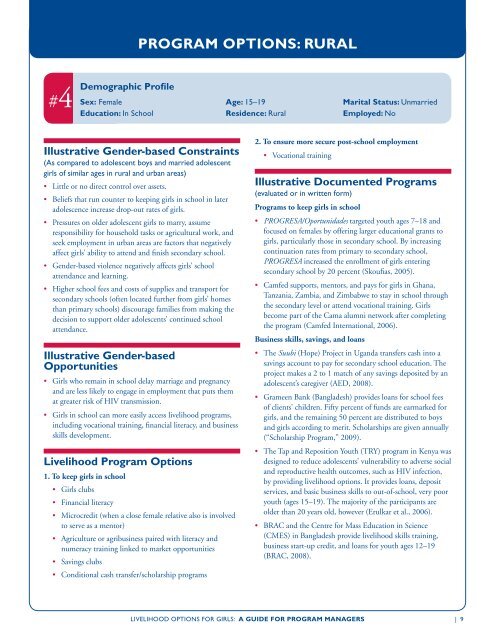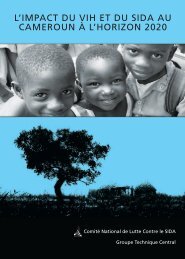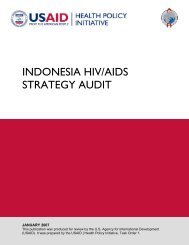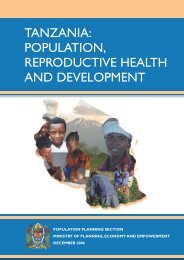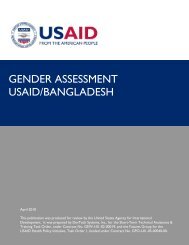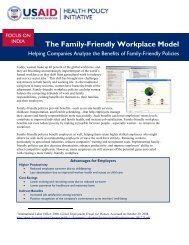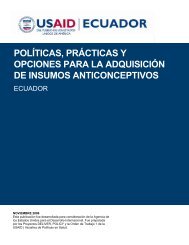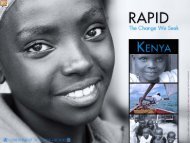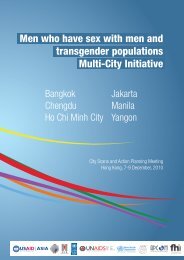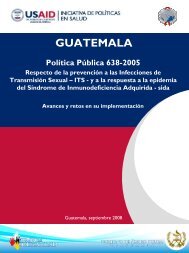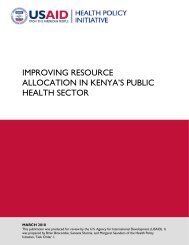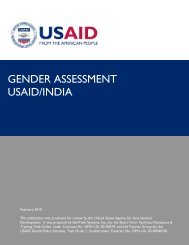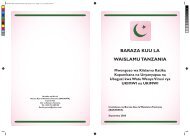LIVELIHOOD OPTIONS FOR GIRLS: - Health Policy Initiative
LIVELIHOOD OPTIONS FOR GIRLS: - Health Policy Initiative
LIVELIHOOD OPTIONS FOR GIRLS: - Health Policy Initiative
- No tags were found...
You also want an ePaper? Increase the reach of your titles
YUMPU automatically turns print PDFs into web optimized ePapers that Google loves.
PROGRAM <strong>OPTIONS</strong>: RURAL4Demographic Profile# Sex: Female Age: 15–19 Marital Status: UnmarriedEducation: In School Residence: Rural Employed: NoIllustrative Gender-based Constraints(As compared to adolescent boys and married adolescentgirls of similar ages in rural and urban areas)• Little or no direct control over assets.• Beliefs that run counter to keeping girls in school in lateradolescence increase drop-out rates of girls.• Pressures on older adolescent girls to marry, assumeresponsibility for household tasks or agricultural work, andseek employment in urban areas are factors that negativelyaffect girls’ ability to attend and finish secondary school.• Gender-based violence negatively affects girls’ schoolattendance and learning.• Higher school fees and costs of supplies and transport forsecondary schools (often located further from girls’ homesthan primary schools) discourage families from making thedecision to support older adolescents’ continued schoolattendance.2. To ensure more secure post-school employment• Vocational trainingIllustrative Documented Programs(evaluated or in written form)Programs to keep girls in school• PROGRESA/Oportunidades targeted youth ages 7–18 andfocused on females by offering larger educational grants togirls, particularly those in secondary school. By increasingcontinuation rates from primary to secondary school, PROGRESA increased the enrollment of girls entering secondary school by 20 percent (Skoufias, 2005).• Camfed supports, mentors, and pays for girls in Ghana,Tanzania, Zambia, and Zimbabwe to stay in school throughthe secondary level or attend vocational training. Girlsbecome part of the Cama alumni network after completingthe program (Camfed International, 2006).Business skills, savings, and loansIllustrative Gender-based• The Suubi (Hope) Project in Uganda transfers cash into asavings account to pay for secondary school education. TheOpportunitiesproject makes a 2 to 1 match of any savings deposited by an• Girls who remain in school delay marriage and pregnancy adolescent’s caregiver (AED, 2008).and are less likely to engage in employment that puts them • Grameen Bank (Bangladesh) provides loans for school feesat greater risk of HIV transmission.of clients’ children. Fifty percent of funds are earmarked for• Girls in school can more easily access livelihood programs, girls, and the remaining 50 percent are distributed to boysincluding vocational training, financial literacy, and business and girls according to merit. Scholarships are given annuallyskills development. (“Scholarship Program,” 2009).Livelihood Program Options1. To keep girls in school• Girls clubs• Financial literacy• Microcredit (when a close female relative also is involvedto serve as a mentor)• Agriculture or agribusiness paired with literacy andnumeracy training linked to market opportunities• Savings clubs• Conditional cash transfer/scholarship programs• The Tap and Reposition Youth (TRY) program in Kenya wasdesigned to reduce adolescents’ vulnerability to adverse socialand reproductive health outcomes, such as HIV infection,by providing livelihood options. It provides loans, depositservices, and basic business skills to out-of-school, very pooryouth (ages 15–19). The majority of the participants areolder than 20 years old, however (Erulkar et al., 2006).• BRAC and the Centre for Mass Education in Science(CMES) in Bangladesh provide livelihood skills training,business start-up credit, and loans for youth ages 12–19(BRAC, 2008).<strong>LIVELIHOOD</strong> <strong>OPTIONS</strong> <strong>FOR</strong> <strong>GIRLS</strong>: A GUIDE <strong>FOR</strong> PROGRAM MANAGERS | 9


